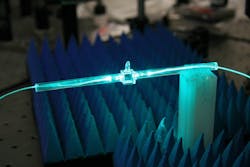Wanted: advanced atomic vapor sensors for quantum information, imaging, communications, and RF electrometry
ARLINGTON, Va. – U.S. military researchers are approaching industry to enhance atomic vapor sensors for electric field sensing, imaging, communications, and quantum information science (QIS).
Officials of the U.S. Defense Advanced research Projects Agency (DARPA) in Arlington, Va., have issued a broad agency announcement (HR001124S0031) for the Enhancing Quantum Sensor Technologies with Rydberg Atoms (EQSTRA) program.
EQSTRA seeks to enhance the performance, capabilities, and maturity of atomic vapor sensors for future compact, calibration-free, small, and lightweight devices with low drift, and quantum-limited accuracy and sensitivity.
Previous research in atomic vapors applications has helped improve vapor-based technologies such as compact atomic clocks, nuclear magnetic gyroscopes. Technologies based on Rydberg atomic vapors hold the potential to enable new capabilities in RF electrometry, imaging, and communications.
Still, Rydberg-based technologies have high sensitivity, fragility, and technical complexities, and have problems that have impeded rapid maturation.
Instead, the EQSTRA program seeks to enhance the capabilities of Rydberg-based technologies extending into the millimeter-wave domain; accelerate Rydberg-based technology development to high TRL and quantum-limited performance; and study Rydberg-based vapor technologies for U.S. military such as quantum-enhanced sensing, imaging, and communications.
EQSTRA seeks to build on the DARPA Science of Atomic Vapors for New Technologies (SAVaNT) program to advance the performance, capabilities, and application landscape of Rydberg-vapor technologies for QIS, quantum-enhanced electrometry, imaging, and communications.
The SAVaNT program, launched in August 2020, sought to develop techniques to mitigate the effects of thermal motion and decoherence within broad categories of vapor-based sensing technologies, and demonstrate new levels of sensitivity, accuracy, and detection bandwidth in vapor-based magnetometers and electrometers.
DARPA awarded a $3.6 million SAVaNT contract in April 2021 to ColdQuanta Inc. in Boulder, Colo., to advance the performance of atomic vapors for electric field sensing in applications ranging from airborne electronic warfare (EW) to naval anti-submarine warfare (ASW). The program aimed to advance the integration of Rydberg-based electrometers to demonstrate a tabletop physics package.
Now researchers want to learn more, through four EQSTRA focus areas: developing atomically referenced tunable, narrow line-width sources of terahertz radiation; developing small and lightweight integrated Rydberg electrometers; developing wafer-scale vapor cells for wideband Rydberg electrometry; and studying Rydberg-based quantum technologies.
Companies interested should submit abstracts by 18 June 2024, and full proposals by 30 July 2024,m to the DARPA Broad Agency Announcement Tool (BAAT) online at https://baa.darpa.mil/Public/SecurityAgreement.
Email questions or concerns to DARPA's Mukund Vengalattore, the EQSTRA program manager, at [email protected]. More information is online at https://sam.gov/opp/c56228ff6cca422290356fdb404cdc8e/view.
About the Author
John Keller
Editor-in-Chief
John Keller is the Editor-in-Chief, Military & Aerospace Electronics Magazine--provides extensive coverage and analysis of enabling electronics and optoelectronic technologies in military, space and commercial aviation applications. John has been a member of the Military & Aerospace Electronics staff since 1989 and chief editor since 1995.

